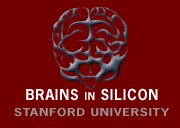Courses: BioE332
Large-scale neural modeling
This course will examine the dynamics of large (>1000) networks of spiking neurons, with particular focus on how these networks achieve cognitive behaviors such as working memory, selective attention, and decision making. The course will feature lectures and labs using Brian, a software simulator, and Neurogrid, a hardware simulator developed in my lab that simulates up to a million spiking neurons in real time. Most of the course will be project-based, allowing you to explore your individual interests using this unique simulation device (or traditional software simulations). While there are certainly many great options for neuroscience courses, I think this one may be particularly interesting for students interested in systems neuroscience, dynamical systems in neuroscience, or large-scale computational modeling.
Catalog Description: Large-scale models link cellular properties, columnar microcircuits, recurrent connectivity, and feedback projections to experimentally studied behaviors such as spike synchrony, selective attention and working memory. Emphasis is on making experimentally testable predictions. Simulations exercises are performed using Brian, a Python-based simulation environment, and Neurogrid, a special-purpose platform developed at Stanford that simulates a million neurons in real-time. In the first half of the course, students replicate models published in the literature. In the second half of the course, students implement and simulate models of their own design.

Modeling Project BioE332 students, Sridhar Devarajan (Neurosci) and Brian Percival (EE), demoing their modeling project on dynamic routing through neuronal coherence. [Winter 2007]
Course Details: Based on modeling projects. Accompanying lectures provide background on systems neuroscience and on modeling techniques.
Prerequisites: A course in neuronal circuits (e.g., BIO 217, NBIO 258), or systems neurobiology (e.g., PSYCH 209A, NBIO 220), or computational neuroscience (e.g., NENS 220).
Goals: Link structure to function by developing circuit-level computational models of the nervous system.
Target Audience: This course is targeted to students already exposed to systems neuroscience and computational methods wishing to learn how to build multiscale models that link neuronal biophysics to neural circuits to cognitive behavior.
BioE332—Spring 2013
Announcements:
Class Time:
Weds & Fri 12:50-2:05pm
Location:
Health Research & Policy T138B
Office Hours:
- Instructor: Kwabena Boahen <SUID: boahen>: Tue 1-2 Clark W125
- Assistant: Tatiana Engel <SUID: tatiana.engel>: Wed 2-4 Clark W1.3
Class notes:
Week 1:
Lecture: Working memory
Discussion: Brian tutorial, modeling background
Reading: Compte et al.
Assignment: Working memory
Extension Presentation:
Week 2:
Lecture: Decision making
Discussion: Working memory modeling results
Reading:
Wang 2002, Wong and Wang 2006
Assignment: Decision making
Extension Presentation:
Week 3:
Lecture: Balanced networks
Discussion: Decision making modeling results
Reading:
Litwin-Kumar and Doiron 2012, Van Vreeswijk and Sompolinsky 1996
Assignment: Clustered balanced networks
Week 4:
Lecture: Neurogrid Hardware
Lecture: Neurogrid Programming I
Week 5:
Lecture: Neurogrid Programming II
Discussion: Decision Making results
Presentation: Project proposals
Week 6: No lecture/discussion
Week 7: No lecture/discussion
Week 8:
Lecture: Project progress presentations
Discussion: Project progress presentations
Week 9: No lecture/ discussion
Week 10: No lecture/ discussion
Week 11 (Finals week):
Lecture: Final project presentations
Discussion: Final project presentations
Previous Years:

